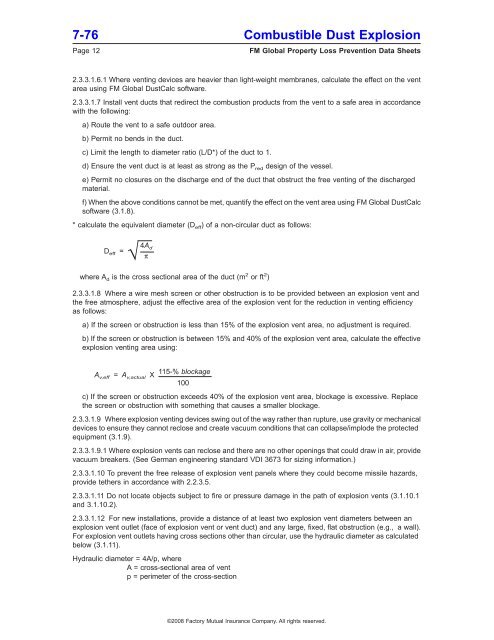DS 7-76 Prevention and Mitigation of Combustible Dust ... - FM Global
DS 7-76 Prevention and Mitigation of Combustible Dust ... - FM Global
DS 7-76 Prevention and Mitigation of Combustible Dust ... - FM Global
You also want an ePaper? Increase the reach of your titles
YUMPU automatically turns print PDFs into web optimized ePapers that Google loves.
7-<strong>76</strong> <strong>Combustible</strong> <strong>Dust</strong> Explosion<br />
Page 12 <strong>FM</strong> <strong>Global</strong> Property Loss <strong>Prevention</strong> Data Sheets<br />
2.3.3.1.6.1 Where venting devices are heavier than light-weight membranes, calculate the effect on the vent<br />
area using <strong>FM</strong> <strong>Global</strong> <strong>Dust</strong>Calc s<strong>of</strong>tware.<br />
2.3.3.1.7 Install vent ducts that redirect the combustion products from the vent to a safe area in accordance<br />
with the following:<br />
a) Route the vent to a safe outdoor area.<br />
b) Permit no bends in the duct.<br />
c) Limit the length to diameter ratio (L/D*) <strong>of</strong> the duct to 1.<br />
d) Ensure the vent duct is at least as strong as the P red design <strong>of</strong> the vessel.<br />
e) Permit no closures on the discharge end <strong>of</strong> the duct that obstruct the free venting <strong>of</strong> the discharged<br />
material.<br />
f) When the above conditions cannot be met, quantify the effect on the vent area using <strong>FM</strong> <strong>Global</strong> <strong>Dust</strong>Calc<br />
s<strong>of</strong>tware (3.1.8).<br />
* calculate the equivalent diameter (D eff) <strong>of</strong> a non-circular duct as follows:<br />
D eff = √ 4A d<br />
π<br />
where A d is the cross sectional area <strong>of</strong> the duct (m 2 or ft 2 )<br />
2.3.3.1.8 Where a wire mesh screen or other obstruction is to be provided between an explosion vent <strong>and</strong><br />
the free atmosphere, adjust the effective area <strong>of</strong> the explosion vent for the reduction in venting efficiency<br />
as follows:<br />
a) If the screen or obstruction is less than 15% <strong>of</strong> the explosion vent area, no adjustment is required.<br />
b) If the screen or obstruction is between 15% <strong>and</strong> 40% <strong>of</strong> the explosion vent area, calculate the effective<br />
explosion venting area using:<br />
A v,eff = A v,actual X<br />
115-% blockage<br />
100<br />
c) If the screen or obstruction exceeds 40% <strong>of</strong> the explosion vent area, blockage is excessive. Replace<br />
the screen or obstruction with something that causes a smaller blockage.<br />
2.3.3.1.9 Where explosion venting devices swing out <strong>of</strong> the way rather than rupture, use gravity or mechanical<br />
devices to ensure they cannot reclose <strong>and</strong> create vacuum conditions that can collapse/implode the protected<br />
equipment (3.1.9).<br />
2.3.3.1.9.1 Where explosion vents can reclose <strong>and</strong> there are no other openings that could draw in air, provide<br />
vacuum breakers. (See German engineering st<strong>and</strong>ard VDI 3673 for sizing information.)<br />
2.3.3.1.10 To prevent the free release <strong>of</strong> explosion vent panels where they could become missile hazards,<br />
provide tethers in accordance with 2.2.3.5.<br />
2.3.3.1.11 Do not locate objects subject to fire or pressure damage in the path <strong>of</strong> explosion vents (3.1.10.1<br />
<strong>and</strong> 3.1.10.2).<br />
2.3.3.1.12 For new installations, provide a distance <strong>of</strong> at least two explosion vent diameters between an<br />
explosion vent outlet (face <strong>of</strong> explosion vent or vent duct) <strong>and</strong> any large, fixed, flat obstruction (e.g., a wall).<br />
For explosion vent outlets having cross sections other than circular, use the hydraulic diameter as calculated<br />
below (3.1.11).<br />
Hydraulic diameter = 4A/p, where<br />
A = cross-sectional area <strong>of</strong> vent<br />
p = perimeter <strong>of</strong> the cross-section<br />
©2008 Factory Mutual Insurance Company. All rights reserved.

















